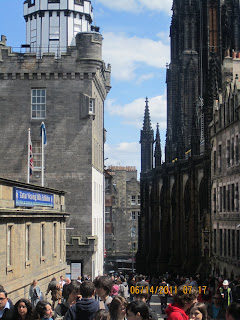We crossed the bridge to get onto the Isle of Skye, population 10,000. On Monday we drove to Dunvegan Castle - home of the clan McLeod. Beautful scenery on the way
Typical scene, area of water with some grassland and rugged hills towering beyond.
Dunvegan castle from the front. Some places are called castles because they were built on the foundations of ancient castles and not because they are true castles (fortesses for military control of specific areas). This is more of a very old stone mansion. No pictures allowed inside.
Dunvegan Castle from the side. We are standibng on the lower battlements where cannon controlled the crossing points of two lochs and one sea inlet.
There are beautiful gardens at the back of the castle. There is a 200 year old Monkey Puzzle Tree in the garden that originates from Chile. Very interesting, somewhat like a pine tree.
Actual branches of the Monkey Puzzle Tree. The tree was a puzzle to us until we were told what it was from one of our fellow travelers.
The McLeod fairy bridge - One of the clan chiefs was married to a fairy who was called back to her family. When she crossed the fairy bridge, she dropped a flag for the McLeod clan which she said could be unfurled twice in time of need, but to beware of unfurling it the third time. It is said to have been unfurled twice. Once during an epidemic, and once during an attack from the MacDonald's. Both times it stopped the disasters from happening.
Eilean Donan Castle - a castle completely surrounded by water at high tide. Although there is a land entrance now, when it was built, there was only a water entrance for around two hundred years.
Ariel view of Eileen Donan. It was never captured by force while the Scots held it. During the rising of 1745 it was garrisoned by the Spanish while the Scots gathered at the orders of "Bonnie Prince Charlie". The Spaniards surrendered it to the Campbells (who were fighting for the English) who promptly blew it sky high when they found hundreds of tons of gunpowder stored in it. It was restored during the early 1900's.
Scene for a local mountaintop.
Our tour director, Geoff Cordwell. He was fantastic. Really sanguine and really into what he was presenting. Got Barb into the singing and clapping of various songs. He had a different tie for each day representing different countries.
The coach driver, Mark. He did an awesome job of negotiating sharp turns, very narrow roads and oncoming traffic, plus dodging sheep that were on the road.
This was the "sunset" view from our hotel window on the Isle of Skye. Taken around 11:30 PM (I couldn't sleep until very late on a number of evenings.) But the sun really never sets all the way this far north at this time of the year. It was beautiful.
A bit about our tour group. Of the 43 people on the tour 2 are Canadian, 20 are American and 21 are from Australia. It has been a very good group and we have met some wonderful people. The Australians seem to travel a lot as most were in Europe before this tour or are staying several more weeks after this tour. A discusion on Vegamite will come later.






























































